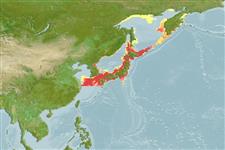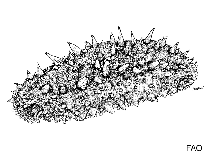Apostichopus japonicus (Selenka, 1867)
Japanese sea cucumber| Native range | All suitable habitat | Point map | Year 2050 |

|
| This map was computer-generated and has not yet been reviewed. |
| Apostichopus japonicus AquaMaps Data sources: GBIF OBIS |
Классификация / Names народные названия | синонимы | CoL | ITIS | WoRMS
Holothuroidea | Synallactida | Stichopodidae
Environment: milieu / climate zone / пределы глубины / distribution range экология
; пределы глубины 0 - 200 m (ссылка 635), usually 50 - 100 m (ссылка 635). Subtropical; ? - 30°C (ссылка 77134), preferred 16°C (ссылка 107945); 63°N - 31°N, 117°E - 165°E (ссылка 112755)
Distribution страны | регионы FAO | Ecosystems | места находок | интродукции
Northwest Pacific: Japan (from Hokkaido to Kyushu), China, Korean Peninsula and Far Eastern Russia (Karaginskogo Island).
Length at first maturity / Size / Weight / Возраст
половая зрелость: Lm ?, range 20 - ? cm Max length : 30.0 cm TL самец/пол неопределен; (ссылка 101467)
Life cycle and mating behavior половая зрелость | размножение | нерест | Eggs | Fecundity | Larvae
Основная ссылка
ссылки | координатор | соавторы
Kan-no, M. and A. Kijima 2003 Genetic differentiation among three color variants of Japanese sea cucumber Stichopus jamponicus. Fisheries Science 69:806-812. (ссылка 77132)
Статус Красного Списка МСОП
(ссылка 130435: Version 2025-1)
Статус СИТЕС (ссылка 108899)
CMS (ссылка 116361)
Угроза для людей
Использование человеком
рыболовство: коммерческий; аквакультура (рыбоводство): коммерческий
FAO - аквакультура (рыбоводство): production, Видовой профиль; рыболовство: landings | FishSource | Sea Around Us
инструменты
дополнительная информация
ресурсы в Интернет
BHL | BOLD Systems | CISTI | DiscoverLife | FAO(аквакультура (рыбоводство): Видовой профиль; рыболовство: ; publication : search) | Fishipedia | GenBank (Геном, Нуклеотид) | GloBI | Gomexsi | Google Books | Google Scholar | Google | PubMed | Tree of Life | Wikipedia (Вперёд, поиск) | Zoological Record



